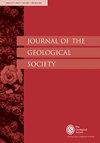Stratigraphic and geographic distribution of dinosaur tracks in the UK
IF 3
3区 地球科学
Q2 GEOSCIENCES, MULTIDISCIPLINARY
引用次数: 0
Abstract
Dinosaur tracks are a key means of determining the palaeoecology and distribution of dinosaurs through time. They provide a highly complementary information source to the body (skeletal) fossil record but differ in preserving direct evidence of animals’ interactions with their environment. The UK has a rich history of ∼200 yrs of dinosaur track discovery but no recent synthesis exists. Here, we present a new dataset of dinosaur tracks in the UK. This dataset shows a close correlation between the distribution of terrestrial sediments and the preservation of dinosaur tracks through the Mesozoic, providing discrete snapshots into dinosaur communities in the Upper Triassic, Middle Jurassic and Lower Cretaceous. The dinosaur track record shows similar broad patterns of diversity and relative abundance of the major dinosaur groups (Theropoda, Sauropodomorpha, Ornithopoda, and Thyreophora) through time to the body fossil record, although differs in that body fossils are found (albeit infrequently) in marine sediments. There is a broad trend towards higher numbers of track occurrences through time and a notable increase in the relative abundance of ornithopod tracks following the Jurassic-Cretaceous boundary. The track record remains an underutilised resource with the potential to provide a much fuller view of Mesozoic dinosaur ecosystems. Supplementary material: https://doi.org/10.6084/m9.figshare.c.6606634英国恐龙足迹的地层和地理分布
恐龙足迹是确定恐龙古生态和分布的关键手段。它们为身体(骨骼)化石记录提供了高度互补的信息来源,但在保存动物与环境相互作用的直接证据方面有所不同。英国有着大约200年的恐龙足迹发现的丰富历史,但目前还没有合成的化石。在这里,我们展示了一个新的英国恐龙足迹数据集。该数据集显示了中生代陆地沉积物的分布与恐龙足迹的保存之间的密切相关性,为上三叠纪、中侏罗纪和下白垩纪的恐龙群落提供了离散的快照。恐龙的足迹记录显示,随着时间的推移,主要恐龙群(兽脚目、蜥脚形目、鸟臀目和Thyreophora)的多样性和相对丰度与身体化石记录相似,尽管不同之处在于在海洋沉积物中发现了身体化石(尽管很少)。随着时间的推移,足迹出现的数量呈上升趋势,侏罗纪-白垩纪边界之后,鸟脚类足迹的相对丰度显著增加。该记录仍然是一种未充分利用的资源,有可能提供更全面的中生代恐龙生态系统视图。补充材料:https://doi.org/10.6084/m9.figshare.c.6606634
本文章由计算机程序翻译,如有差异,请以英文原文为准。
求助全文
约1分钟内获得全文
求助全文
来源期刊

Journal of the Geological Society
地学-地球科学综合
CiteScore
6.00
自引率
3.70%
发文量
68
审稿时长
6-12 weeks
期刊介绍:
Journal of the Geological Society (JGS) is owned and published by the Geological Society of London.
JGS publishes topical, high-quality recent research across the full range of Earth Sciences. Papers are interdisciplinary in nature and emphasize the development of an understanding of fundamental geological processes. Broad interest articles that refer to regional studies, but which extend beyond their geographical context are also welcomed.
Each year JGS presents the ‘JGS Early Career Award'' for papers published in the journal, which rewards the writing of well-written, exciting papers from early career geologists.
The journal publishes research and invited review articles, discussion papers and thematic sets.
 求助内容:
求助内容: 应助结果提醒方式:
应助结果提醒方式:


